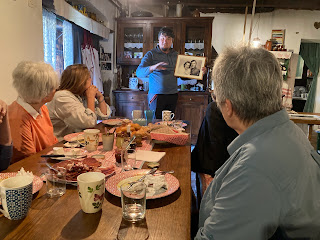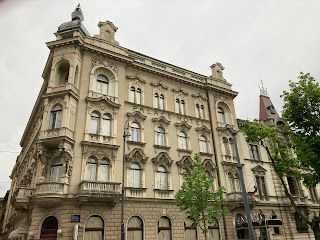We spent the entire morning at the living history farm in Karanac. The first order of business was morning coffee, followed by the unveiling of the cheese we had helped make the previous afternoon.
Our cheesemaker returned and helped us unpack it after it had remained in the press overnight. We had it with our breakfast, and it was quite good.
After breakfast, our host gave us some of his family history and explained a bit more about the background of the farm.
Mary wasn't feeling well -- hit by allergies or a head cold, we're not sure which. So she sat out much of the morning activities. That meant that I had to step in and help with kitchen duties, as our hostess directed us in the preparation of goulash for lunch. We are only 15 miles from the Hungarian border here, so goulash is part of the culture.
Every ingredient came from the farm. Our host had soaked white beans overnight in large earthenware pots, and had taken smoked ham and put it in water to rinse out the salt. This morning, he built a wood fire, and since it was a gorgeous morning, we set up to chop vegetables at long tables in an outdoor kitchen. The farmhouses here all have two kitchens -- one indoors around a huge wood oven to use in winter, and another outdoors around a fire pit to use in summer.
When preparation was complete, the finely chopped carrots, onions, parsnips, and other veggies were added to the beans in the clay pots, and the pots were set next to the fire. Tomato paste, lots of paprika, and a bit of black pepper were added.
While waiting for this stew to cook, the group was invited into a room in the barn that had been converted into a pottery studio. Our host's cousin is a professional potter, and since the secret to authentic goulash appears to be the use of clay pots, the segue was made to pottery.
The demonstration was fascinating. I have watched potters at the wheel before, but never have I seen anything like this. This man's skill and creativity were amazing. He told us that he used to use expensive pottery tools, but now his equipment is mostly common kitchen implements, such as a cheese cutter and a garlic press.
He then gave group members some clay and challenged them to a competition, but these were not works of art. We all received one of his cups, with the town name on it, as a consolation prize.
The goulash still needed a bit of time, so our tour leader took us on a village walk. We visited the two-room schoolhouse (but since it was Sunday, we only saw the outside) and learned more about the education system.
We walked past the things that every village needs -- post office, grocery store, and bar -- plus the fire volunteer fire department and a winery. There were also three churches: Roman Catholic, Orthodox, and Calvinist (unusual for Croatia, but more common in Hungary, not far away).
We returned just in time for our goulash lunch, and while it wasn't really like any goulash I've had before, it was very good.
Following lunch, we packed up, left our rooms, and boarded the bus for the trip to Croatia's capital city, Zagreb. The ride was four hours on the interstate-type divided highway, and uneventful.
One of every four Croatians reside in greater metropolitan Zagreb. A brief orientation walk introduced us to some of the old buildings. Many still show damage from a major earthquake here just two years ago. We are located in the city center, not far from some of the older buildings of the university and a beautiful central park.
We returned for a buffet dinner in the hotel restaurant, then called it a night. We will explore more of this city tomorrow with a local guide.











No comments:
Post a Comment